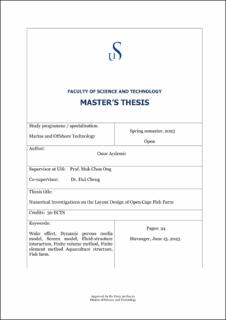| dc.description.abstract | Aquaculture, one of the fastest-growing food production method, has become Norway's second-largest export industry in the past decades. In Norway, the high-value fish like Atlantic Salmon are usually raised in multi-cage fish farms. In the design of these fish farms, the unknown flow velocities within the farm make it difficult to estimate the drag forces on individual cages, thereafter the loads on mooring system. Additionally, as fish farms move to open seas for better environments, fish cages face increased loads from larger waves and faster currents, leading to higher tension in mooring lines and reduced cultivation volume. Addressing these challenges is crucial for optimizing aquaculture system design.
This thesis mainly focuses on the two key issues: the environmental load on downstream fish cages and the structural responses of two different layout designs of fish farms.
The first part of the thesis investigates wake effects on drag forces on fish cages using CFD and a porous medium model. Different cage placements and solidities are considered in the investigation. One interesting finding is that downstream fish cages can experience higher drag forces than upstream cages, particularly when positioned between α = 30° and α = 70°. Additionally, higher solidity will increase drag forces on fish cages. These findings can improve the understanding of the wake effects inside of multi-cage fish farms.
The second part of this thesis presents investigates the fluid-structure interaction in fish farms using a coupling algorithm that combines OpenFOAM and Code_Aster. This part mainly focuses on the structural responses and flow fields of a 2 × 3 Array layout and a new Honeycomb layout design. The study compares flow characteristics, anchor line tensions, drag forces, and cultivation volumes under different flow angles. Results suggest that the Honeycomb layout offers a smaller covered area in the sea, reduced environmental loads, and improved operational efficiency, making it an advantageous approach for fish farming. | |
